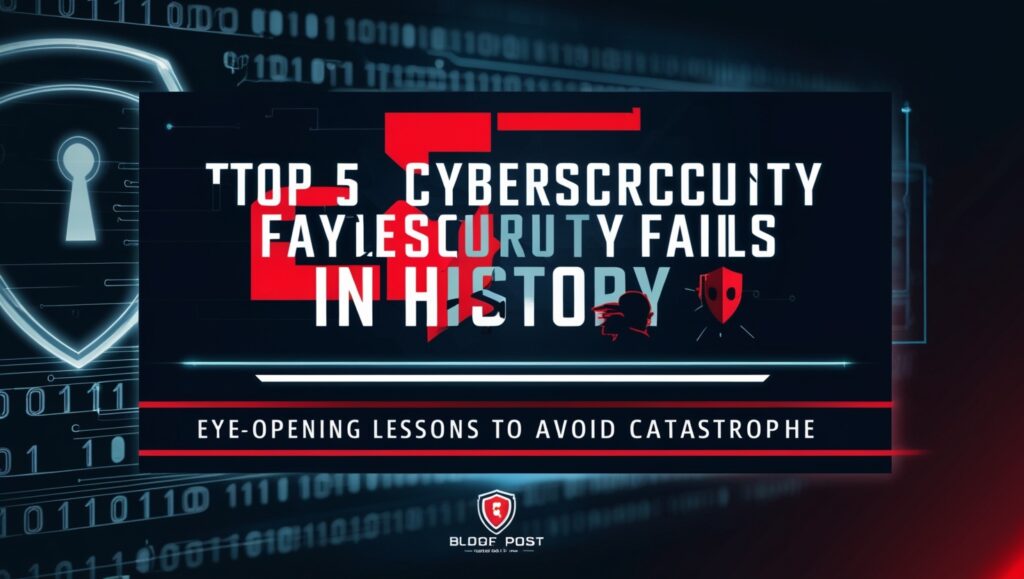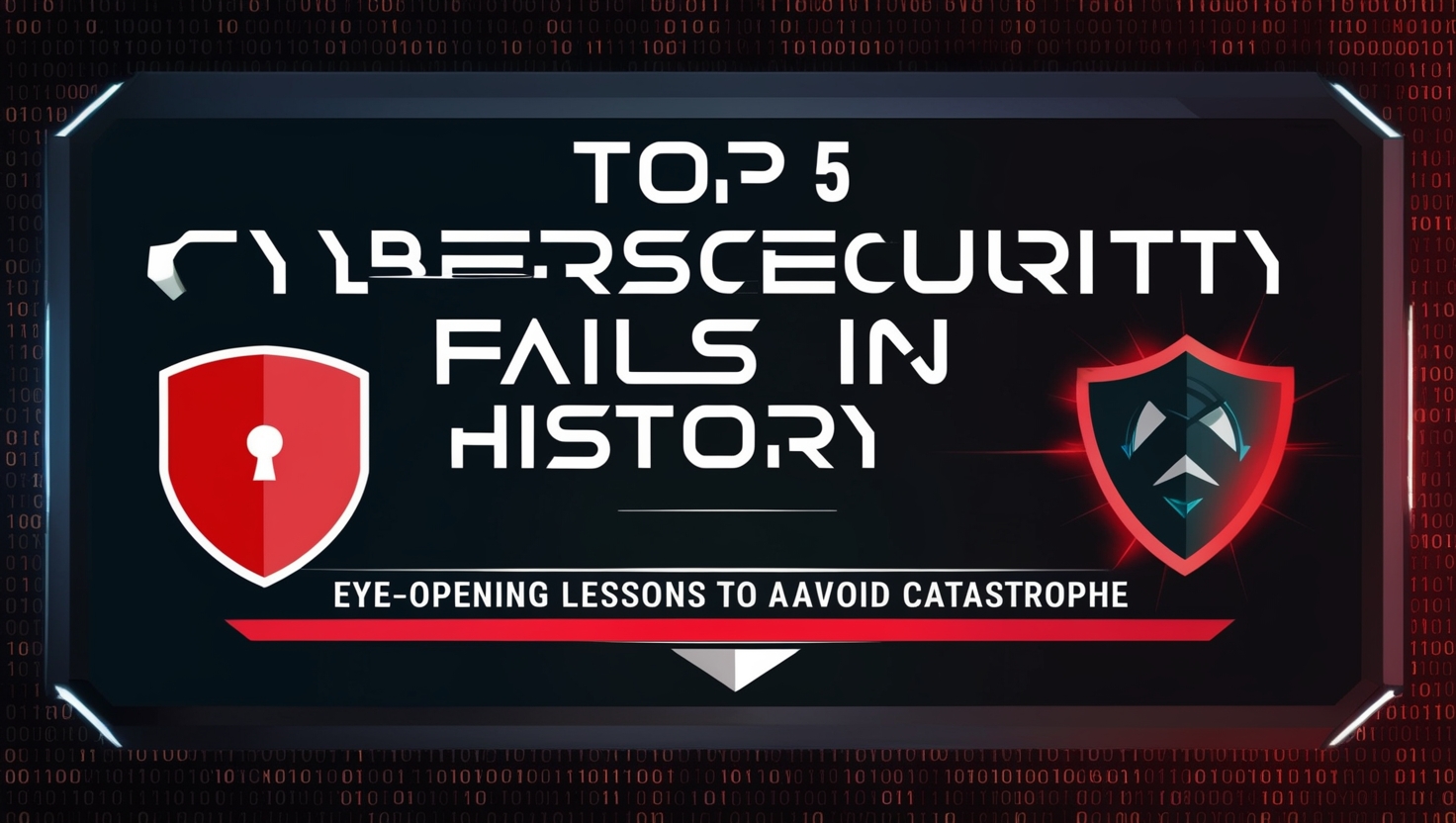Top 5 Cybersecurity Fails in History: Lessons from Major Breaches
In today’s digital age, cybersecurity is more critical than ever. With businesses, governments, and individuals relying heavily on technology, the consequences of a single cybersecurity fail can be catastrophic. In this blog, we’ll explore the Top 5 Cybersecurity Fails in History, uncovering what went wrong and the lessons we can learn to prevent similar disasters.

Introduction: The Growing Importance of Cybersecurity
Cybersecurity is no longer just an IT concern—it’s a global priority. From personal data breaches to attacks on critical infrastructure, the stakes have never been higher. Despite advancements in technology, some of the biggest organizations in the world have fallen victim to cyberattacks due to simple oversights. These Top 5 Cybersecurity Fails in History serve as a stark reminder of what can go wrong when security is neglected.
1. The Equifax Data Breach (2017): A Failure in Patch Management
In 2017, Equifax, one of the largest credit reporting agencies, suffered a massive data breach that exposed the personal information of 147 million people. The cause? A failure to patch a known vulnerability in their web application framework, Apache Struts.
- What Happened?
Hackers exploited the unpatched vulnerability to gain access to sensitive data, including Social Security numbers, birth dates, and addresses. - Why It Matters:
This breach highlighted the importance of timely patch management. A simple update could have prevented one of the most significant cybersecurity fails in history. - Lesson Learned:
Regularly update and patch software to protect against known vulnerabilities.
2. The Yahoo Data Breaches (2013-2014): The Largest Data Breach in History
Yahoo’s data breaches in 2013 and 2014 are considered the largest in history, affecting 3 billion user accounts. The company’s failure to disclose the breaches for years made the situation even worse.
- What Happened?
Hackers stole user data, including names, email addresses, and hashed passwords. The breach was attributed to weak encryption and outdated security practices. - Why It Matters:
The delay in disclosure eroded trust and led to a $350 million reduction in Yahoo’s sale price to Verizon. - Lesson Learned:
Transparency and robust encryption are essential for maintaining user trust and security.
3. The WannaCry Ransomware Attack (2017): A Global Wake-Up Call
The WannaCry ransomware attack in 2017 affected over 200,000 computers across 150 countries, including critical systems like the UK’s National Health Service (NHS).
- What Happened?
The ransomware exploited a vulnerability in Microsoft Windows, encrypting files and demanding Bitcoin payments for their release. - Why It Matters:
The attack disrupted hospitals, businesses, and government agencies, causing billions in damages. - Lesson Learned:
Keep systems updated and invest in robust backup solutions to mitigate ransomware risks.
4. The Target Breach (2013): A Third-Party Vendor Disaster
In 2013, retail giant Target suffered a breach that exposed 40 million credit card details and 70 million customer records. The attack originated through a third-party HVAC vendor.
- What Happened?
Hackers stole the vendor’s credentials to access Target’s network, installing malware on point-of-sale systems. - Why It Matters:
This breach underscored the risks of third-party vendors and the importance of securing all access points. - Lesson Learned:
Implement strict access controls and regularly monitor third-party connections.
5. The Colonial Pipeline Ransomware Attack (2021): A Critical Infrastructure Failure
The Colonial Pipeline ransomware attack in 2021 disrupted fuel supplies across the U.S. East Coast, causing widespread panic and price hikes.
- What Happened?
Hackers used a single compromised password to access the pipeline’s network, deploying ransomware that forced the company to shut down operations. - Why It Matters:
This attack highlighted the vulnerability of critical infrastructure to cyber threats. - Lesson Learned:
Strengthen password policies and implement multi-factor authentication to protect critical systems.
Conclusion: Lessons Learned from These Cybersecurity Fails
The Top 5 Cybersecurity Fails in History teach us valuable lessons about the importance of proactive security measures. From timely patching to robust encryption and third-party monitoring, these incidents remind us that cybersecurity is everyone’s responsibility. By learning from these mistakes, we can build a safer digital future.
FAQ Section
1. What is the biggest cybersecurity fail in history?
The Yahoo data breaches (2013-2014) are considered the largest, affecting 3 billion user accounts.
2. How can businesses prevent cybersecurity fails?
Regular updates, strong encryption, employee training, and third-party monitoring are key.
3. Why is patch management important?
Patching fixes known vulnerabilities that hackers can exploit, as seen in the Equifax breach.
4. What role do third-party vendors play in cybersecurity?
Third-party vendors can be weak links, as demonstrated by the Target breach.
5. How can individuals protect themselves from cyber threats?
Use strong passwords, enable multi-factor authentication, and stay informed about potential risks.

Leave a Reply